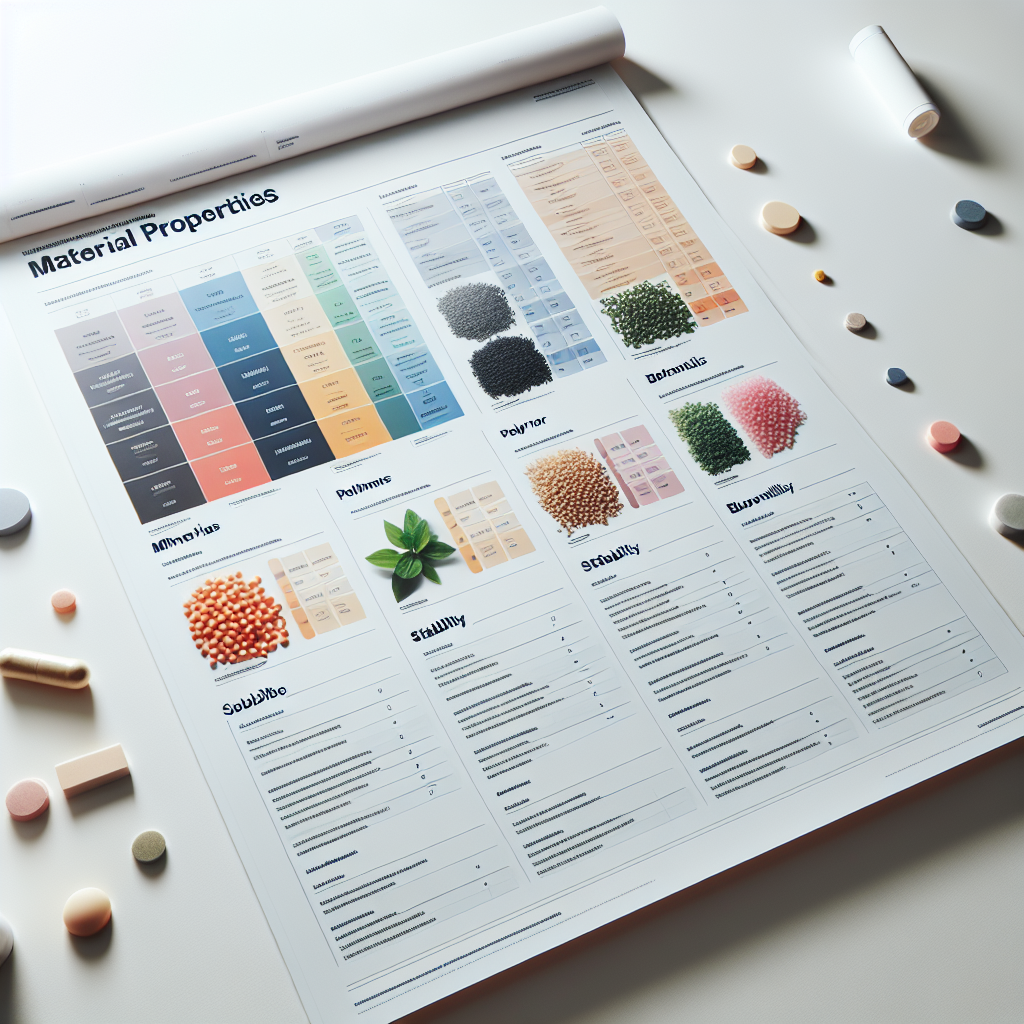In the world of product development and manufacturing, there exists an unsung hero that determines everything from a product’s lifespan to its performance capabilities – material hardness. This fundamental property serves as the invisible blueprint behind nearly every product we interact with daily, yet remains largely overlooked by those outside engineering circles. For forward-thinking supplement manufacturers, enterprise businesses requiring strategic ingredient partnerships, and R&D companies developing nutritional products, understanding material hardness is not just beneficial – it’s essential for success.
Material hardness, simply defined, is a material’s resistance to permanent deformation when a force is applied. This property influences countless aspects of product development, from raw material selection to processing techniques and ultimately, product durability. In the nutritional supplement industry, where product integrity and consistency are paramount, material hardness considerations extend beyond equipment to include the processing of ingredients themselves.
Understanding Material Hardness Testing Methods
To effectively utilize material hardness in product development, manufacturers must first understand how hardness is measured. The industry has standardized several testing methods, each with specific applications across different materials and manufacturing scenarios.
Brinell Hardness Test
The Brinell hardness test, one of the oldest standardized tests, involves applying force to the material through steel or carbide balls. A specified load is applied to a hardened steel ball of specific diameter, creating an indentation in the test material. The Brinell Hardness Number (BHN) is calculated by dividing the load by the surface area of the indentation.
This method is particularly valuable for nutritional product manufacturers working with raw materials of varying consistency or when evaluating the durability of processing equipment. The test works exceptionally well for heterogeneous materials, making it ideal for natural ingredient processing equipment where consistency is critical.
Rockwell Hardness Test
Perhaps the most widely used method globally, the Rockwell hardness test measures the permanent depth of indentation produced by a force/load on an indenter. What makes this test particularly valuable is its ability to provide direct hardness value readings without complex calculations.
The Rockwell method employs several scales denoted by letters. The most common are:
- Rockwell B scale (HRB): For softer materials, using a 1/16″ steel ball indenter
- Rockwell C scale (HRC): For harder materials, using a diamond cone indenter
For nutritional product developers, the Rockwell test proves invaluable when selecting processing equipment that must withstand continuous operation while maintaining precise tolerances – critical for supplement consistency and quality.
Vickers Hardness Test
The Vickers test applies a prescribed load using a diamond pyramid indenter with a 136-degree angle between opposite faces. The resulting hardness value is calculated by dividing the load by the surface area of the indentation. What sets this test apart is its precision across extremely thin materials and surface layers.
Small businesses and R&D companies developing innovative delivery systems for nutritional products – such as micro-encapsulation technology – often rely on Vickers testing to ensure material integrity at microscopic levels.
Knoop Hardness Test
Similar to the Vickers test, the Knoop test uses a diamond indenter but with an elongated pyramid shape. This specialized approach allows for testing extremely thin materials or surface treatments, making it essential for evaluating specialized coatings on nutritional manufacturing equipment or testing thin-film delivery systems for supplements.
Navigating Hardness Scales for Optimal Material Selection
Beyond testing methods, understanding various hardness scales provides the framework for intelligent material selection in product development. Each scale serves specific purposes across different industries and applications.
Mohs Hardness Scale
Developed in 1812 by Friedrich Mohs, this scale ranks minerals from 1 (talc) to 10 (diamond) based on their ability to scratch one another. While relatively simple compared to other scales, the Mohs scale remains valuable for comparing the relative hardness of natural ingredients used in nutritional formulations.
Health-conscious product manufacturers often use this scale when evaluating natural mineral ingredients or when considering how different natural components will interact during processing. For instance, understanding that a particular mineral ingredient ranks higher on the Mohs scale may indicate potential abrasiveness in processing equipment over time.
Brinell Hardness Scale
The Brinell scale provides readings from approximately 500 to 3000 BHN, making it particularly suitable for evaluating materials used in heavy-duty processing equipment. Nutritional product manufacturers relying on high-volume production often consider Brinell hardness when selecting equipment components that must withstand continuous use without compromising precision.
Rockwell Hardness Scale
With multiple scales (A through V), the Rockwell system offers exceptional versatility across various materials. The most commonly used scales include:
- HRB: For copper alloys, soft steels, and aluminum alloys
- HRC: For hard steels, titanium, and hardened alloys
Enterprise businesses requiring strategic ingredient partnerships often specify Rockwell hardness requirements for processing equipment to ensure consistent production quality across global supply chains. Understanding these specifications allows for better communication between ingredient suppliers and manufacturers.
Vickers Hardness Scale
The Vickers scale provides exceptional precision across an extremely wide range of materials, from very soft to extremely hard. Its versatility makes it invaluable for R&D companies developing new delivery systems for nutritional products, where material interactions at microscopic levels can significantly impact bioavailability.
Material Hardness: The Cornerstone of Design and Machining Excellence
The relationship between material hardness and manufacturing processes directly impacts product quality, especially in nutritional product development. This connection influences everything from equipment selection to processing parameters.
Design Implications
Material hardness serves as a critical factor in equipment design for supplement manufacturing. Engineers must consider:
Wear Resistance: Higher hardness typically correlates with better wear resistance, crucial for equipment handling abrasive natural ingredients.
Deformation Resistance: Equipment components must maintain precise tolerances despite continuous operation, with hardness directly impacting dimensional stability.
Load-Bearing Capacity: Processing equipment handling bulk materials requires components with appropriate hardness to support operational loads without deformation.
For nutritional product developers, these considerations extend beyond equipment to the ingredients themselves. Understanding how different ingredients behave under processing conditions – including their relative hardness – allows for optimized formulations and processing parameters.
Machining Considerations
Material hardness directly influences machining processes critical to manufacturing precision equipment:
Tool Selection: Harder materials require specialized cutting tools, impacting production costs and timelines.
Cutting Parameters: Feed rates, cutting speeds, and depth of cut must be adjusted based on material hardness.
Surface Finish: Material hardness affects achievable surface finishes, which can be critical for food-grade equipment.
Health-conscious product manufacturers must consider these factors when designing production processes, as they directly impact the consistency and quality of nutritional products. For example, tableting equipment must be precision-engineered to handle ingredients of varying hardness while maintaining consistent compression forces – directly affecting supplement disintegration and dissolution rates.
The Critical Connection: Material Hardness and Nutritional Product Manufacturing
The relationship between material hardness and nutritional product quality extends beyond manufacturing equipment to ingredients themselves. This connection manifests in several critical ways:
Ingredient Processing and Bioavailability
The hardness of raw materials can significantly impact how they respond to processing techniques, affecting:
Particle Size Reduction: Harder ingredients require more energy to mill or grind, potentially affecting heat-sensitive nutrients.
Blending Uniformity: Ingredients with vastly different hardness properties may segregate during mixing, creating consistency challenges.
Tableting Performance: Compression properties directly correlate with ingredient hardness, affecting tablet hardness, friability, and dissolution profiles.
Forward-thinking supplement manufacturers recognize that ingredient hardness isn’t just a processing consideration – it directly impacts bioavailability. Ingredients that are too hard may not properly disintegrate in the digestive tract, potentially reducing nutrient absorption.
Equipment Durability and Product Consistency
In nutritional product manufacturing, equipment durability directly influences product consistency:
Wear Patterns: Equipment components with inadequate hardness develop wear patterns that can alter critical processing parameters over time.
Precision Maintenance: Understanding material hardness helps establish appropriate maintenance schedules before wear affects product quality.
Material Transfer: Components that contact ingredients must maintain appropriate hardness to prevent metal transfer or contamination.
Strategic ingredient partnerships between suppliers and manufacturers often involve detailed specifications about processing requirements, including considerations of material hardness throughout the production chain.
NutraAeon’s Approach: Aligning Material Science with Nutritional Excellence
At NutraAeon, we recognize that material hardness is far more than an engineering specification – it’s a foundational element in our quality-focused philosophy. As a global nutritional ingredients partner, we’ve integrated hardness testing principles into our comprehensive quality control protocols, ensuring that every ingredient we source meets the exacting standards our clients demand.
Our approach to ingredient sourcing embodies three core principles that align perfectly with material hardness testing methodology:
Quality Through Rigorous Testing
Just as material hardness testing provides objective measurements of material properties, NutraAeon applies rigorous testing protocols to every ingredient in our portfolio. Our quality control extends beyond industry standards, incorporating advanced analytical techniques to verify not just identity and purity, but functional characteristics that impact processing and bioavailability.
For our Amino Acid Series, including premium L-Theanine, L-Tryptophan, L-Serine, and Glycine, we conduct comprehensive physical property testing to ensure consistent performance in various formulation types. Similarly, our Vitamin Series undergoes stability testing under various processing conditions to guarantee potency throughout the manufacturing process and shelf life.
Transparency in Material Specifications
Material hardness charts provide clear, objective data about material properties – eliminating guesswork in engineering decisions. Similarly, NutraAeon believes in complete transparency throughout the ingredient supply chain. Every ingredient we provide comes with comprehensive documentation, including certificates of analysis and full supply chain visibility.
This transparency extends to processing recommendations, where we provide detailed guidance on optimal handling of ingredients based on their physical properties – including considerations related to hardness and compression characteristics when applicable.
Empowering Formulation Excellence
Understanding material hardness empowers engineers to make informed decisions about material selection and processing. In the same way, NutraAeon empowers our partners with technical expertise, regulatory guidance, and innovative ingredient solutions.
Our technical team collaborates closely with clients to ensure that ingredients from our Mineral Series, including our premium Magnesium Oxide, perform optimally in their specific applications – considering everything from particle size distribution to compression properties for tablet formulations.
Conclusion: The Enduring Value of Material Hardness Understanding
The material hardness chart represents far more than a technical reference – it embodies a fundamental approach to quality and performance that transcends industries. For forward-thinking supplement manufacturers, enterprise businesses requiring strategic ingredient partnerships, small businesses, R&D companies, nutritional product developers, and health-conscious product manufacturers, understanding material hardness provides a competitive edge in an increasingly demanding marketplace.
By incorporating these principles into ingredient selection, equipment specification, and process design, manufacturers can develop nutritional products that not only meet but exceed consumer expectations for quality and efficacy. In a marketplace where quality differentiation is increasingly challenging, this scientific approach to material selection and processing can make the critical difference between ordinary products and exceptional ones.
At NutraAeon, we remain committed to bridging the gap between global ingredient excellence and forward-thinking manufacturers, providing the premium-quality raw materials and technical expertise needed to create standout nutritional products. By embracing the scientific principles behind material hardness testing and applying them throughout our quality control processes, we help our partners create products that truly stand apart in today’s competitive landscape.


